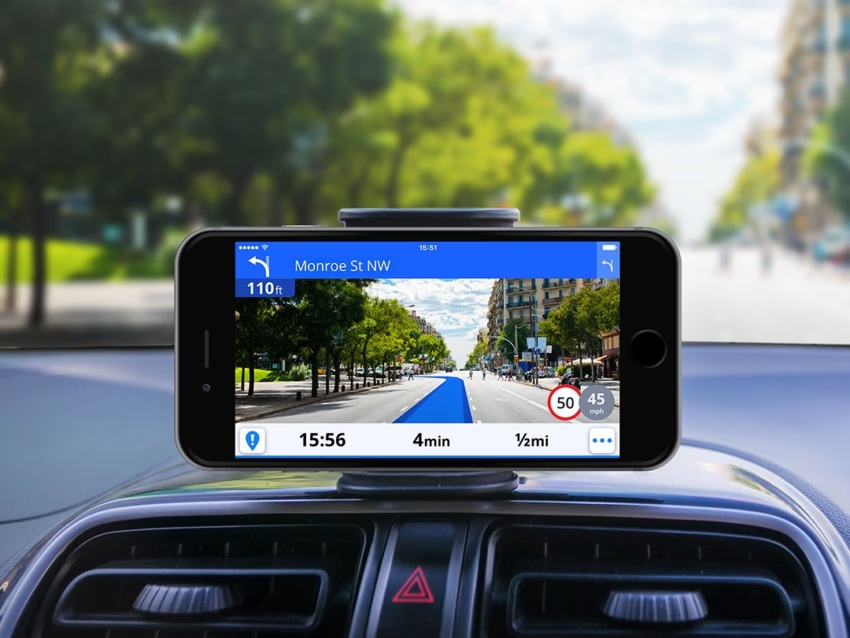
How to Make a GPS App Like Waze?
Do you want to launch a GPS (Global Positioning System) navigation app? You need to know how to make a GPS app like Waze.
With our extensive software development experience, we at DevTeam.Space can guide you.
We first explain the utility of GPS apps. We briefly review a few popular GPS apps. After discussing the required features of a GPS app, we explain the app development process.
How does a GPS app help?
GPS navigation apps on smartphones help users significantly. When you want to travel from point A to point B, you can get directions from GPS apps.
These apps can collect and process data related to traffic jams in real time. GPS navigation apps provide you with an optimal route from your current location to the destination.
You get routing information including turn-by-turn directions. GPS tracking apps use various location tracking and mapping technologies for this.
The market for navigation systems is growing rapidly. Whether in the defense industry or a company like Uber, the use of navigation systems has increased significantly.
A Mordor Intelligence report states that the navigation systems market will register a CAGR of 11.3% during the 2021-2026 period.

Get a complimentary discovery call and a free ballpark estimate for your project
Trusted by 100x of startups and companies like
A brief overview of GPS apps like Google Maps and Waze
The two most popular GPS navigation apps are as follows:
1. Google Maps
Google launched Google Maps first in 2005. You can use the web version of this mapping application. Google Maps offers an Android app, furthermore, there’s an iOS app.
Google Maps offers the following:
- Satellite imagery:
- Aerial photography;
- Street maps;
- 360-degree interactive panoramic views of streets;
- Real-time traffic conditions;
- Routing information for travel.
Developers can use the Google Maps SDKs and APIs to incorporate mapping functions in their apps.
2. Waze
A few programmers from Israel launched FreeMap Israel in 2006. They launched a company named Waze later. The company changed the name of this GPS navigation app to Waze.
Google acquired Waze in 2013.
Waze is available both on Android and iOS. It offers the following:
- Routing information to users based on crowdsourced information;
- The ability for users to report traffic-related incidents;
- Alerts to users about traffic jams and other traffic incidents;
- The ability to modify the map data using a map editor;
- The ability to choose the navigation voice;
- Lane guidance;
- Trip suggestions;
- Support for Android Auto;
- Support for Apple CarPlay.
The key features of a GPS navigation app like geolocation, navigation, etc.
You should offer the following features when you make a GPS navigation app:
- User management;
- User authentication;
- Options to select a mode of transportation;
- Geolocation feature and navigation;
- Voice directions in a step-by-step manner;
- Rerouting;
- Integration with popular messaging apps;
- Social media integration;
- Push notifications/in-app messages;
- Support for the languages used by your target audience;
- The ability to download maps for use when the user doesn’t have an Internet connection;
- In-app purchases and payment gateway integration.
You need to target key mobile device platforms like Android and iOS. Focus on the user experience.
How to develop a geolocation app like Waze for navigation?
Take the following steps:
1. Build a small team to plan the GPS tracking app development project
Form a small team led by an experienced project manager (PM). You need a software architect, furthermore, you need a team of business analysts (BAs).
You need to explain the high-level objectives of the project to this team. E.g., explain your pricing models, target audience, etc. Specify the platforms you want to target, e.g., web, Android, iOS, etc.
This team should do the following:
- Business analysts need to gather requirements and document them.
- The software architect needs to design the technical solution.
- The PM needs to lead this team to come up with a project plan.
2. Gather, document, and manage the requirements for the proposed GPS tracking application development
BAs need to gather and document the functional requirements. They need to conduct structured interviews with the business stakeholders. BAs need to get insights from potential users.
They need to consider various aspects, e.g.:
- User experience;
- How the app will use data like Cell ID from mobile operators;
- Utilizing data from cell towers;
- How the proposed app will use WiFi network data;
- The kind of algorithms required in the app;
- The information security regulatory standards to meet while processing user's location data;
- Whether the app will use the “Assisted GPS” (A-GPS) technology;
- Whether the app will offer Augmented Reality (AR)-powered GPS features;
- The user authentication requirements to be followed;
- Integration with social networks.
The software architect needs to define the non-functional requirements (NFRs), e.g.:
- Security;
- Usability;
- Maintainability;
- Performance;
- Scalability.
The team needs to write the requirements document effectively. Following a thorough review, the PM should get the necessary approvals.
The PM needs to implement an effective requirements management process.
3. Plan the MVP for the proposed GPS app
You plan to launch mobile apps, which are consumer-facing. You will likely enhance your mobile application frequently. The Agile development methodology works well for such iterative development.
As a part of that, we recommend you launch an MVP (Minimum Viable Product) first. An MVP is a functional product with fewer features.
You can validate your business ideas and assumptions by launching an MVP.
Get market feedback, and enhance your app based on it. You should prioritize features for the MVP. As we have described in our MVP guide, use tools like the pain-and-gain map and prioritization matrix.
4. Evaluate 3rd party APIs to develop an app like Waze
You will likely develop your own APIs. However, you might use 3rd party APIs for some features. Evaluate the following 3rd party APIs:
Hire expert developers for your next project
1,200 top developers
us since 2016
Mapbox
Mapbox, a well-known platform offers maps and location data. Note the following key facts about Mapbox:
The Mapbox web services APIs enable you to access the Mapbox tools and services from your app.
These APIs cover functions like mapping, navigation, search, and accounts.
You can use the Mapbox mobile SDKs for Android and iOS to integrate Mapbox services into your app.
Mapbox offers extensive documentation for developers.
Google Maps
Do you plan to use step-by-step navigation features in your app? You can’t use Google Maps APIs in that case since the terms and conditions won’t allow it. You can use it otherwise.
Note the following quick facts about the Google Maps developer platform:
Google Maps APIs allow you to incorporate maps and routes. You can integrate place-related information.
This platform offers location features through satellite data, like street view imagery, geocoding, geolocation, street view imagery, distance matrix, elevation, and time zones.
You can access GPS data and GPS coordinates to incorporate them into GPS applications.
Google Maps offers Android, iOS, and JavaScript SDKs.
You can access the extensive Google Maps platform documentation.
Foursquare
You can use Foursquare APIs in your proposed GPS app. Foursquare is a well-known location technology platform. It offers the following:
- Scalability;
- Accessibility;
- Accurate data;
- Data privacy and security;
- Descriptive place profiles;
- A “Places API” to search for places;
- A “Places database” with valuable content in formats like JSON and TSV;
- Android and iOS SDKs;
- Extensive documentation.
5. Choose the right tech stack for developing a GPS app
Select the appropriate technology stack. We recommend the following:
What are Non-Functional Requirements?
You should develop a native Android application. Native apps make the best use of hardware features available on different mobile devices.
They offer the best user experience, performance, and security.
We recommend you use Java for native Android development. It’s a popular choice for many Android developers. This enterprise-scale language offers great performance and security.
Note: Kotlin, a modern programming language is becoming a popular choice for native Android development. You can use it too.
Swift for native iOS development
We recommend you develop a native iOS app for the best user experience, performance, and security. Swift, a modern language is a right choice for native iOS development.
Swift delivers performance, security, productivity, and maintainability. Apple prefers it, which helps with ASO ( Mobile App Stores Optimization).
Note: Many developers earlier used Objective-C for iOS development. It’s a robust language, however, Swift has gained more popularity.
Databases
We recommend PostgreSQL or MySQL if you need an RDBMS (Relational Database Management System). Both of these open-source SQL databases offer robust performance and scalability.
Hire expert developers for your next project
If you need a NoSQL database, then we recommend MongoDB or Apache Cassandra. These open-source NoSQL databases offer excellent scalability and performance.
API development
We recommend you use the REST (Representational State Transfer) standard for developing your own APIs. It’s the de-facto standard for API development.
Mobile Back-end
You would like to focus on front-end development and business logic. Use an MBaaS (Mobile-Backend-as-a-Service) platform.
Popular cloud computing providers offer MBaaS platforms that manage the cloud infrastructure and persistent storage.
This makes it easier to develop and manage the mobile back end. AWS Amplify is an example of an MBaaS platform.
Other technologies
You might use a few more technologies/tools depending on your requirements, e.g.:
- Geofencing API from Google;
- The region monitoring API from Apple;
- GPS technology and location services from Google;
- The Core Location API from Apple to process location data;
- iBeacon, the Bluetooth communication protocol from Apple.
6. Plan your geolocation app development project
Now that you have identified the required APIs/SDKs and tech stack, you can plan the project. Include the following:
Plans for Iterations: We recommend you use the “Scrum” framework, which is useful for Agile projects. This framework involves iterations called “Sprints”.
Each Sprint should include a few features, which you need to plan for.
- Human resource plan: Plan for hiring a competent development team.
- Estimation: Estimate the effort and costs.
- PM&T: Plan for the appropriate software development processes, methods, and tools.
- Security: Plan to mitigate key application security vulnerabilities.
Focus on the other key aspects like risk management, communications management, quality management, etc. Define the metrics that you will measure.
7. Hire a competent software development team
You need to hire the following roles:
- UI designers;
- Native Android developers;
- Native iOS developers;
- Testers;
- DevOps engineers.
You might think of hiring from freelance platforms, however, we don’t recommend that. Freelance platforms don’t provide management support.
Hire developers from reputed software development companies. They provide full-time developers with skills and experience. They provide management support too.
8. Execute, monitor, and control the project
Your development team needs to code the Android and iOS apps. Use Android Studio, the popular IDE for Android development. Use Xcode for iOS development.
Implement a structured code review process. Test the Android and iOS apps.
Use the Android development guidelines to publish the Android app in Google Play. Publish the app on the Apple App Store by following the relevant guidelines.
Monitor the key metrics. Take corrective actions when applicable. Evaluate the performance of your GPS app by monitoring the relevant product management KPIs.
Final thoughts
We explained what GPS navigation apps do, and we reviewed a few examples. We described how to build a GPS app like Waze.
Contact DevTeam.Space if you need help with a GPS app development project.
FAQs
Your business requirements influence the choice of native vs cross-platform development. Native Android or iOS mobile applications deliver better user experience, performance, and security than cross-platform apps. Cross-platform mobile development has lower software development costs.
DevTeam.Space has developed several apps for Apple’s platforms like iOS. We have expert Swift developers. Our developers focus on functionality as well as non-functional requirements. Whether developing location-based apps for social media apps or entertainment, our developers have vast experience.
DevTeam.Space has end-to-end software development capabilities including location-based app development and project management. Our dedicated account managers work closely with you. They ensure that our development teams deliver your requirements, furthermore, they provide robust project management support.



